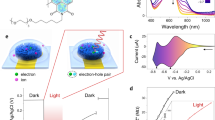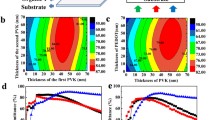Abstract
Optocouplers (optoisolators) were fabricated using semiconducting polymers. The input unit is a polymer light emitting diode with an external quantum efficiency of ∼1% photons/electron. The output unit is a polymer photodiode with a quantum yield of ∼35% electrons/photon at 590 nm. Both units can be operated at bias voltages sufficiently low to be compatible with TTL and complementary metal-oxide semiconductor logic circuits. Since the transfer characteristic is nearly linear, the polymer optocoupler can be used in analogue circuits as well. The current transfer ratio reaches 2 × 10−3 under-10V reverse bias, comparable to that of commercial inorganic optocouplers.
Similar content being viewed by others
References
J. H. Burroughes, D. D. C. Bradley, A. R. Brown, R. N. Marks, K. Mackay, R. H. Friend, P. L. Burns and A. B. Holmes,Nature 347, 539 (1990).
D. Braun and A.J. Heeger,Appl. Phys. Lett. 58, 1982 (1991).
Recent developments on polymer LEDs can be found, for example,in Electroluminescent Materials, Devices, andLarge-Screen Displays, eds. E.M. Conwell, M. Stolka and M.R. Miller (Bellingham.WA, 1993).
D. Braun, A. J. Heeger and H. Kroemer,J. Electron. Mater. 20, 945 (1991).
G. Gustafsson, Y. Cao, G. M. Treacy, F. Klavetter, N. Colaneri and A.J. Heeger,Nature 357, 477 (1992).
G. Yu, C. Zhang and A. J. Heeger,Appl. Phys. Lett. 64, 1540 (1994).
For examples, see: (a) U. Tietze, C. Schenk and E. Schmid,ElectronicCircuits:DesignandApplications (Berlin:Springer-Verlag, 1991) p. 99; (b) S. Gage, D. Evans, M. Hodapp and H. Sorenson,Optoelectronics Application Manual (New York: McGraw-Hill, 1977).
D. Braun, G. Gustafsson, D. McBranch and A. J. Heeger,J. Appl. Phys. 72, 564 (1992).
G. Yu, K. Pakbaz and A. J. Heeger,Appl. Phys. Lett. 64, 3422 (1994).
R. Sugimoto, S. Takeda, H. B. Gu and K. Yoshino,Chemistry Express 1, 635 (1986).
F. Wudl, P.-M. Allemand, G. Srdanov, Z. Ni and D. McBranch,Materials for Nonlinear Optics: Chemical Perspectives, Vol. 455 eds. S.R. Marder, J.E. Sohn and G.D. Stucky, (Washington, DC: American Chemical Society, 1991) p. 683.
I. D. Parker,J. Appl. Phys. 75, 1656 (1994).
Author information
Authors and Affiliations
Rights and permissions
About this article
Cite this article
Yu, G., Pakbaz, K. & Heeger, A.J. Optocoupler made from semiconducting polymers. J. Electron. Mater. 23, 925–928 (1994). https://doi.org/10.1007/BF02655366
Received:
Issue Date:
DOI: https://doi.org/10.1007/BF02655366




